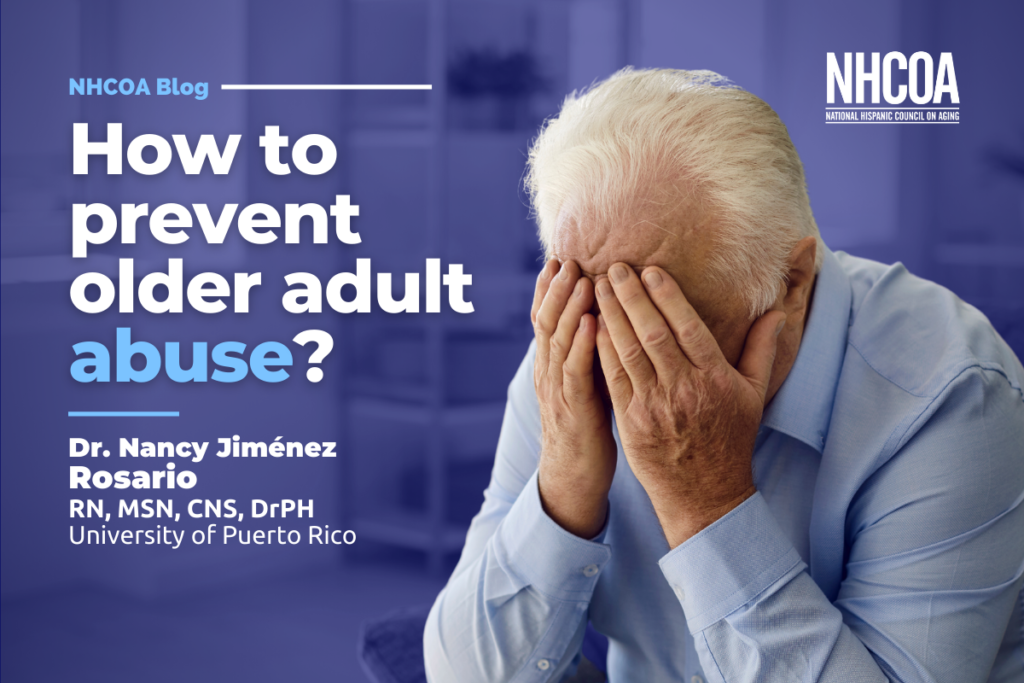
Dra. Nancy Jiménez Rosario RN, MSN, CNS, DrPH
Professor
University of Puerto Rico- Arecibo Campus
According to the World Health Organization (WHO, 2022) in 2021, one in 6 people over 50 suffered some type of abuse in the community. During the COVID-19 pandemic, the rates of elder abuse increased significantly. Elder abuse can lead to serious physical injuries and psychological harm with long-term consequences. The world’s population of adults over 60 will double to 2 billion by 2050. Consequently, abuse committed against older adults is expected to increase.
According to the National Institute on Aging (NIA, 2020), although men also suffer abuse and mistreatment, females and widowed women are the most vulnerable victims of abuse. The most vulnerable older adults are those with no close friends or family or have some form of dependency; such as those with mental and physical disabilities, memory problems, dementia, or various chronic diseases.
Types of elder abuse
There are different types of abuse, including:
- Psychological or emotional abuse occurs when a person expresses themselves with hurtful words that impact the older adults’ self-esteem or humiliate them. This abuse is also seen when older adults are yelled at, threatened and/or ignored repeatedly. Another form of psychological or emotional abuse is when they are prevented from seeing family members or loved ones.
- Physical abuse is experienced when an older adult is assaulted, beaten, pushed, or slapped. Being hit with an object such as a belt or strap is a form of physical abuse. Furthermore, being locked in a room or being physically held against their will is considered physical abuse.
- Sexual abuse can happen when someone forces an older adult to have sex or engage in sexual activity with another person against their will.
- Financial abuse is when someone steals the money or belongings of an older adult. Forging checks and stealing retirement pensions, social security benefits, or nutritional assistance benefits is financial abuse. Sometimes abusers use credit cards or request them without the consent of the older adult. Victims of financial abuse can find their will, bank accounts, and life insurance policies altered. Many times older adults can be victims of healthcare fraud, in which healthcare providers and health professionals charge more or sometimes bill Medicare or Medicaid for medical services or procedures that were not performed.
- Negligence can occur when the person in charge of the care of the older adult does not attend to their emotional, social, and physical needs. It is considered negligent when a caregiver does not supply the older adult with food or medicine, or prevent them from receiving medical attention.
- Abandonment happens when an older adult is left alone when they require constant supervision and attention to meet their needs.
Elder abuse can occur in many places; their home, in a family member’s house, in an assisted living place, and even in nursing homes. Abuse can be committed by family members, strangers, caregivers, or even health professionals (NIA, 2020).
Signs and symptoms of abuse
Abuse can be identified when an older adult:
- Does not engage in activities that they previously enjoyed
- Displays poor hygiene and an unkempt personal appearance
- Has difficulty sleeping
- Is distracted, agitated, and sometimes irritable or violent
- Has lost appetite and weight
- Shows bruises or evidence of physical abuse
- Has broken glasses, or there is evidence of signs of violence
- Lacks assisted medical equipment, e.g. wheelchair, canes, medical bed, lack of medications, does not attend medical appointments
- Lives in poor housing conditions (the house is dirty or there is no food)
- Has received notices of charges or suspension notices of basic necessities like energy and water services. In the most severe cases, they receive a notice of eviction from housing for lack of payments.
Where to seek help in case you or a family member experiences any signs of abuse
In case you know of someone who shows signs of abuse, you should provide immediate help through the following means:
- Talk to the victim in private
- Offer to take them to a safe place where they can be helped
- Ask your local senior protective services agencies for help
- Contact the Community Living administration that has a center to help victims of abuse or maltreatment known as the “National Center on Elder Abuse”, here you can report the abuse and receive legal aid
- Use the older adult service locator known as “Eldercare Locator”, which operates Monday through Friday at 800-677-1116
- If they are in imminent danger, immediately call 911 or your local police
- In case of financial abuse, contact the Consumer Financial Protection Bureau at 855-411-2372 or 855-729-2372
- Also, if you suspect the older adult is a victim of financial abuse or fraud, you can call the National Elder Fraud Hotline at 833-372-8311
- Call the National Adult Protective Services Association at 202-370-6292
- Call the National Center on Elder Abuse at 855-500-3537
- If you are a victim of abuse and violence by your partner, you can contact the National Domestic Violence Hotline at 800-799-7233 24/7.
References
National Institute on Aging (2020) Maltrato y Abuso de las personas mayores. Retrived on June 27, 2022.[ https://www.nia.nih.gov/espanol/abuso-personas-mayores].
Organización Mundial de la Salud (OMS, 2022) Maltrato de las personas mayores. Retrived on June 27, 2022. [who.int/es/news-room/fact-sheets/detail/Elder-abuse].
Links

Recent Comments